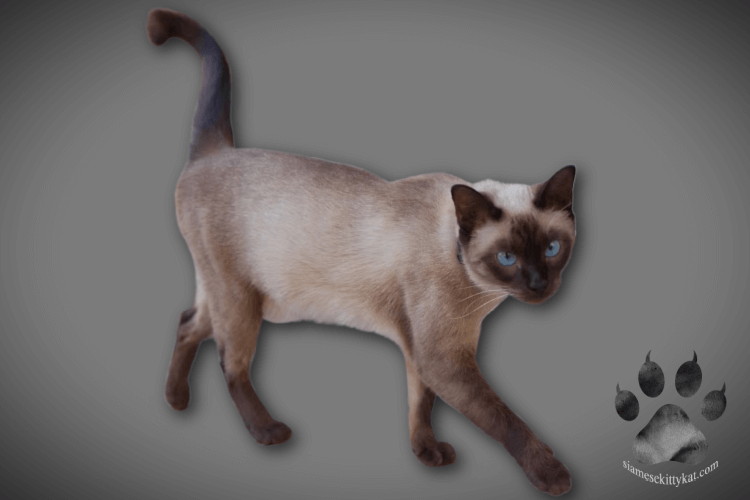Being a human cat toy is a stressful and often painful occupation. Your furry pal bites hard, and you have no idea why at other times. Your Siamese cat gives playful bites out of excitement most of the time.
Most Siamese cats attack due to overstimulation. Many scratch and bite because they get pet the wrong way.
It has been an issue for my Siamese cats in the past, and it lasted a while. Thank goodness, I’ve learned some helpful solutions that subsided my Siamese cats’ attacking behaviors.
Most Siamese cats attack without warning, and we are not sure why. What could be the possible reasons? Let’s find out.
If your Siamese cat’s aggressive behavior stresses you out, keep reading! One of these explanations could be the reason.
Why is my Siamese cat attacking and biting me?
Your Siamese cat overreacts during playtime and is in overstimulation mode.
It may happen during your play dates. Your furry buddy gets so excited when you play with him. Your cat’s senses increase too. This time, your cat’s mind wanders because he is having so much fun.
Overstimulation in playtime may signify a fun bond between you and your cat, so do not let it happen. When your Siamese cat is overstimulated or overexcited, your pal may bite you often. Your excited pal may snarl on your feet and scratch you out of the blue.
These examples of body language show signs of overstimulation:
You should stop playing if you see any of these body language cues. Let your Siamese cat relax and calm down before re-engaging.
What should I do if my Siamese cat is overreacting?
1. Do not try to pick up your Siamese cat if he is still overexcited.
2. If your cat keeps attacking your feet, throw a small toy away from you.
3. Don’t yell at or hurt your cat if he plays too rough. Your cat’s aggressive behavior will only worsen if you hit him or tell your cat off.
4. Don’t always give the cat toys you have to pick up and throw. A wand toy is excellent, as it keeps you from getting too close to your cat. A fishing pole type of toy is perfect too. It prevents your cat from being combative.
How can I keep my Siamese cat from getting overstimulated?
Your cat needs more activities that can help please his drive to hunt.
Siamese cats are natural hunters. If they have limited access to areas full of prey, their desire to stalk and hunt becomes more potent. It often happens, especially with indoor cats.
Your cat sometimes looks for a way to act out his urges to hunt in your home. To your surprise, but not quite, that may include you. With limited outlets for his prey behaviors, your cat may look for other things to chase and bite.
How can I help my indoor cat meet his hunt drive?
Most cats like puffballs that run down the hallways. Some cats like toys with feathers that can stay above them.
Robyn, my Siamese cat, likes small toys that move in surprising ways. Batman likes to play with small balls and toys that look like mice.
You can meet your cat’s hunting needs if you know his favorite prey. Plus, you’ll save money only by buying toys you know your cat will enjoy.
You are petting your Siamese cat the wrong way.
Your Siamese cat bites you sometimes to tell you that he disapproves of your petting style. It’s common for Siamese cats to be vocal. They don’t hesitate to show their displeasure when they don’t appreciate the petting.
You might get a friendly nip from your cat to let you know he doesn’t want you to touch his tummy or tail. Your kitty will tell you when he’s had enough stroking by his twitching tail and sudden bite.
How do I pet my Siamese cat without getting bit or attacked?

Your Siamese cat doesn’t want you to caress his paws.
It’s hard to resist touching your cat’s paws, especially when petting him, right? Siamese cats have great sensitivity to their paws. This is caused by the blood vessels and nerve receptors on their paw pads. Some Siamese cats don’t mind when you touch their paws, but others are not okay with it.
Most cats don’t like the sensation of their paws being touched. Their paws help them figure out how hot or cold the ground is. If you touch your Siamese cat’s paws, he might tense up and pull his leg back, scratch you, or bite you to get away.
Other reasons your Siamese cat may not allow you to touch his paws and may later bite you:
Other signs your cat has injured his paws include persistent meowing and limping. If your cat hurts his paws, take your cat to the vet as soon as possible.
Your Siamese cat is not receiving enough play opportunities.
Siamese cats often crave attention from their favorite humans. They always want their owners to pay attention to them. It’s in their blood to do active things with a companion. They may feel lonely and ignored if you don’t play with them throughout the week.
When this happens, Siamese cats tend to have short temper. If you don’t give your cat enough chances to play, he will be pushy and display attacking behaviors.
How can I ensure my Siamese cat gets enough time and options to play?
Your cat will find it fun and challenging. It’s super beneficial to keep your Siamese cat’s mind, and he won’t get bored fast.
You can use cat trees or cat condos. It helps reduce your cat’s aggressive or destructive behaviors. Give your Siamese cat a toy to play with and watch him climb. You can play peekaboo too.
Be sure the cat you adopt is compatible with your cat.
Your Siamese cat is feeling lonely or depressed.
Siamese cats are born with plenty of energy and vigor. These cats get lonely when they don’t have enough time to release their energy. If your Siamese cat has depression, he might become shy or even act wild. Your furry baby will want to keep nipping or biting you when the latter happens.
What are some signs my Siamese cat is feeling depressed?

How do I prevent depression in my Siamese cat?
Your Siamese cat is angry at you for taking him out of his personal space.
Siamese cats tend to be friendly and clingy. However, they are adamant about protecting their private space. Your cat may wish to stay in their safe zones and keep his sense of security. He may bite you when he thinks you are not respecting his private time.
It’s your cat’s way of telling you he wants to spend more time in his safe, less threatening space.
How do I give my Siamese cat his personal space and time?
Your cat may resort to biting your guests because of it. It’s traumatic for most cats.
Your Siamese kitten may be experiencing teething pain.
Some kittens handle teething well. Others don’t and may try to find ways to make the pain go away.
When your kitten is teething, he may experience discomfort. He may eat less, drool, and bite everything he sees. Your Siamese cat may bite his toys and any fabric he can find.
How can I help my teething kitten?
1. Give your Siamese cat safe teething toys.
2. Avoid brushing your kitten during teething pain.
3. Give your kitten wet food or soften the kibble with warm water.
4. Keep cords and wires out of your kitten’s sight.
5. Take any plants on display out of the house in the meantime. Your kitten may try to chew on the plant.
6. Go to the vet for specific teething remedies.
Other possible reasons your cat is attacking or biting you:
To Wrap It All Up
It’s cute when your Siamese cat nibbles your toes, but it would be best to teach your cat that it is not okay to bite or scratch as soon as possible.
Yes, it’s in your cat’s DNA to attack and bite. Meeting his physical and emotional needs may stop him from acting this way. Buy a lot of valuable toys. Give your Siamese cat enough games and exercises to meet his energy burn needs.
You should take your cat to the vet if he can’t stop attacking. Set a healthy routine for your Siamese cat and teach how you want him to behave. They are intelligent breeds. They’ll understand. Be patient while they are learning. I hope you find this post helpful. Thanks for reading!
Want to learn more about your Siamese cat’s behavior? We have compiled every information you need to navigate through the fascinating world of Siamese cats: Everything About a Siamese Cat’s Behavior: A Comprehensive Guide
Get your FREE Siamese Cat 2024 Printable Calendar


